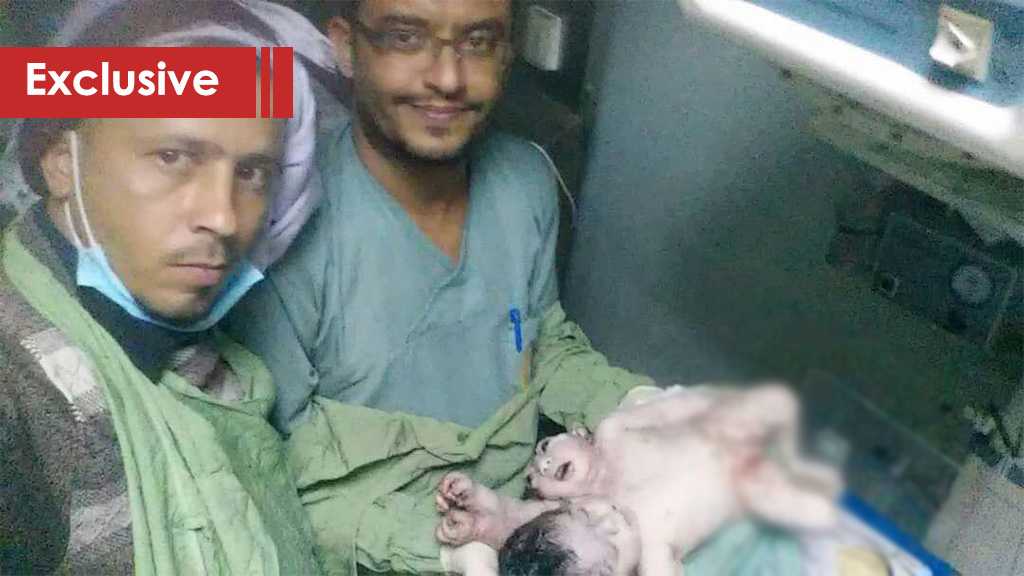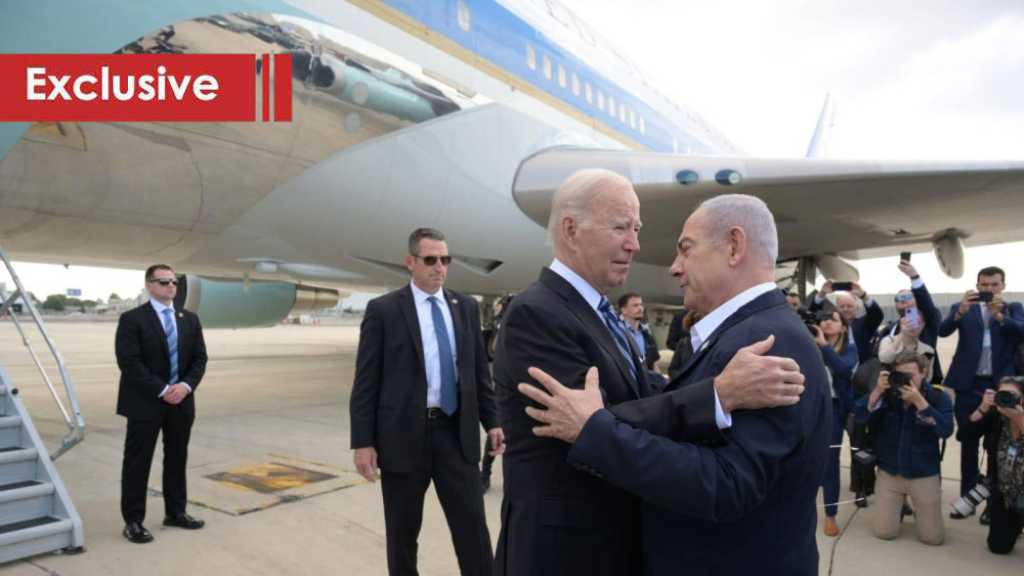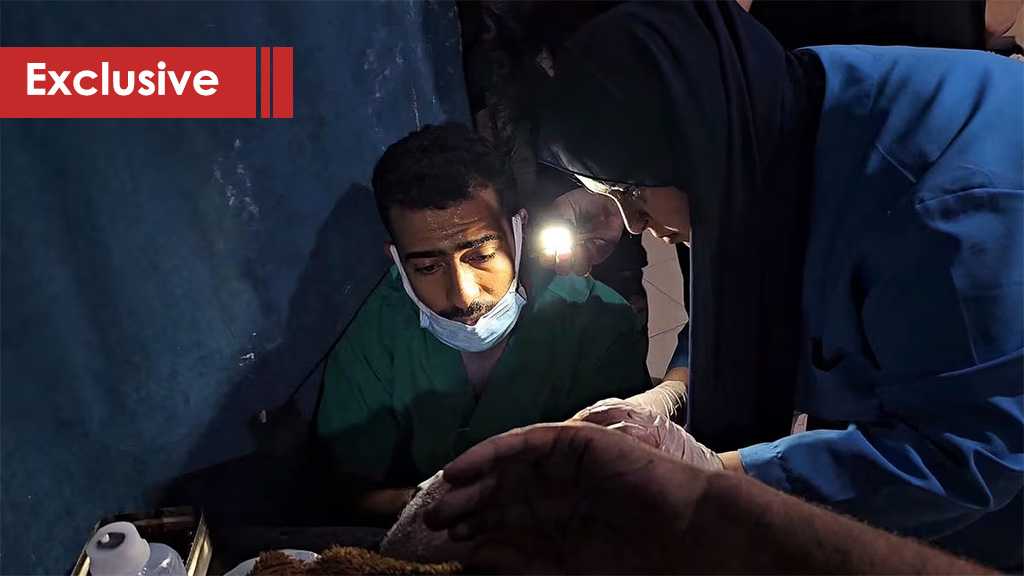
Another Extremely Rare Conjoined Twins Died In Sana’a Far From Western Media Attention

By al-Ahed Correspondent
Sana’a -- Another extremely rare conjoined twins died two months after another similar case died in Sana'a last February as a result of bad health services caused by Saudi Arabia's aggression since March 2015.
One of the newly born was with birth defects causing him to be born dead, the medic says, but the other was fine for just half an hour of birth then died. The unnamed conjoined twins have shed light on the blockade on Yemen imposed by Saudi Arabia amid silence from the UN humanitarian aid groups.
The extremely rare conjoined twins were born earlier in April at Zayed Hospital for Maternal and Childhood northern Sana'a city, but their video has just circulated on media by the Health Ministry Spokesman on Friday 26 April.
Al-Ahed correspondent has visited Zayed Hospital to meet medics and find a way to reach the twins' parents. However, he was able to meet medics but not the parents.
Mohammed al-Raidah and Ibrahim al-Jaryza'a are the two medics who were on shift when the parents of the conjoined twins arrived hospital. The two medics shared a selfie with the conjoined twins after their death.
Al-Ahed correspondent has obtained an image of the medics with the conjoined twins who died before their parents got a chance to even name them.
At the beginning, al-Jaryza'a couldn't remember the exact day when the parents arrived at hospital, but after he resorted to check details of the image, he found it was taken around 1: 40 a.m. on Sunday, 8 April, 2019.
"We received the [unnamed] mother of the twins at 11:30 P.M. on April 7," al-Jaryza'a recalls. "She was at home in case of normal delivery, then suddenly got an obstructing labor so she was transferred to this hospital."
It's not clear if the parents are from Sana'a or not, but the medic said they are living in Dares District northern Sana'a International Airport, which is very close to the Airport that have been witnessing the deadliest airstrikes.
How they were born?
Medic Ibrahim al-Jaryza'a said Dr. al-Khawi decided then to consider a C-section for the mother upon her arrival.
"The C-section began at 12 and ended at 1:30 a.m. on April 8," al-Jaryza'a explained to al-Ahed at the office of the hospital's deputy director, Marwan Qatoub.
Dr. Asma'a al-Khawi who conducted the C-section for the mother was absent on Saturday when al-Ahed correspondent visited the hospital. Then Qatoub called al-Khawi over the phone and set a time for a phone interview with our website.
"The boy with birth defects was born dead, but the other who survived after the birth delivery continued to breath before he died after half an hour," al-Khawi recalls.
The twins were born with two heads and one torso. "They shared their heart, abdominal parts, etc," Dr. al-Khawi told al-Ahed.
Al-Khawi stressed that she did everything for the still-breathing boy, like kick-start but didn't work out and he then died.
"The mother did not know she is pregnant with a twins," Dr. al-Khawi noted, adding that she was told the mother was expecting a natural delivery at home but that did not happen.
"The mother arrived hospital and it was hard to give a proper birth delivery as the two conjoined twins' conjoined hands were already out of the mother womb," said al-Khawi, pointing out that she conducted a C-section operation urgently for the mother due to this situation.
"Hope for survival"
Those twins are the second such case to be reported through media since the launch of the Saudi-led aggression on Yemen. The first conjoined twins died last February at the age of two weeks. They were Abdul-Rahim and Abdul-Khaleq who died at al-Thawrah Hospital in Sana'a.
Al-Khawi said there was hope for the boy who survived for half an hour and was with no birth defects to remain alive.
"There was hope for the other boy to stay alive," al-Khawi confirmed to al-Ahed. She explained that a conjoined twins’ separation surgery of the born dead with birth defects from the boy with no birth defects can give hope for the latter to stay alive.
Mother of the conjoined twins went home from hospital on 10 April in a stable health condition.
Transporting the twins outside Yemen takes time, as Sana'a International Airport is under Saudi Arabia's blockade and only UN flights get access.
The previous Yemeni conjoined twins, Abdul-Khaleq and Abdul-Rahim died aging two weeks last February as a result of negligence after medics' warned they would not be able to survive within Yemen’s war-ravaged health system and needed to go abroad were there are high hopes for them to survive.
Reasons of birth defects
Marwan Qatoub, the Deputy Director of Zayed Hospital for Maternal and Childhood said there has been an increase in cases of premature births, fetal malformations and fetal deaths.
"[These cases] have increased significantly during the last three years since the onset of the [Saudi-led military] aggression against Yemen," Qatoub told al-Ahed.
When hospital medics take data of the mother who gave birth to a child who is deformed or dead or has given an early birth, says Qatoub, medics find that most of the mothers have been living or had lived in areas exposed to missile bombardment of the Saudi coalition's forces.
According to Qatoub, the first impression of war-related birth defects is that "it is caused by weapons, but that is only part of it".
Qatoub says causes of birth defects include lack of treatment, widespread diseases and lack of adequate health care for pregnant women, raising the risk of having a child with congenital malformations.
"Other causes of [malformations] are malnutrition of the pregnant women because due to prolonged siege imposed by the countries of aggression on Yemen and the difficulty of access to food and health treatment," Qatoub noted.
Qatoub concluded that studies indicated that 94% of cases of deformity of the fetuses lie in the poor countries, due to malnutrition of the mother, and folic acid deficiency, which would later cause bone and spinal deformity of the child.



